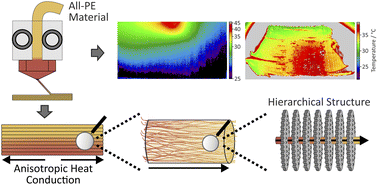High and tuneable anisotropic thermal conductivity controls the temperature distribution of 3D printed all-polyethylene objects†
Abstract
With ongoing miniaturization and weight reduction of portable electronic devices, effective heat dissipation is essential to inhibit malfunctions and premature failure. The application of fillers in a polymer matrix enhances the thermal conductivity of lightweight materials but impedes recyclability. All-polyethylene (all-PE) materials represent a sustainable and easy-to-recycle single-material alternative, whereby high and tunable thermal conductivity is provided by process-induced hierarchical PE nanostructures. Essential for this type of composite-free high-performance material is the specific PE composition containing high amounts of ultra-high molecular weight PE that form ultrastrong extended-chain nanostructures induced by shear and elongational flow during processing. This results in self-reinforcing fibre-like shish-kebab nanostructures with a high thermal conductivity parallel to the extended PE chains. Extrusion-based 3D printing enables tuning the orientation of the PE nanostructure to tailor the orientation and magnitude of the thermal conductivity. Thus, this material class highlights the possibility of combining digitally programmable heat management in 3D printed materials with sustainable material concepts.



 Please wait while we load your content...
Please wait while we load your content...